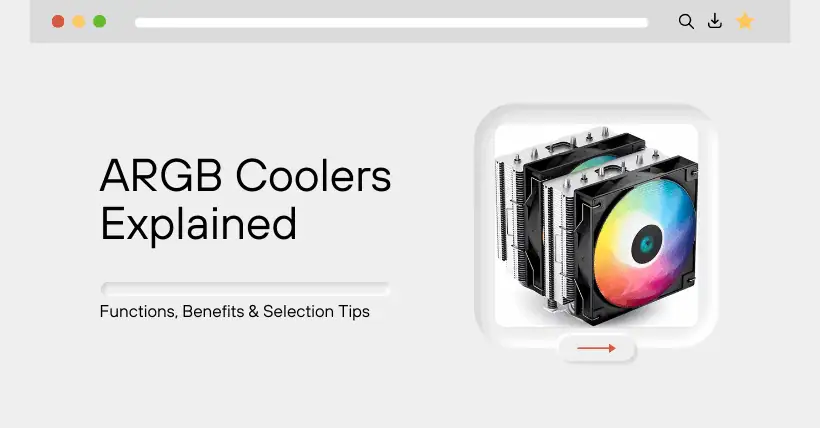1. Introduction
In the minds of many, the typical structure of a CPU cooler has long been thought of as a simple metal block with a fan, seemingly without much technological sophistication. When selecting a cooler, most people usually only consider compatibility, size, cooling efficiency, and price.
However, this perception is now quite outdated. In recent years, there have been notable innovations in cooler technology, such as the addition of lighting effects that allow for vibrant and customizable light displays. At first glance, some may dismiss this as merely adding a few LEDs with little technical value.
Yet, the reality is different. This article will help readers understand what an “ARGB cooler” truly is, along with essential knowledge and considerations for choosing one.
2. What is an ARGB Cooler?
To understand “ARGB cooler,” let’s first break down the term “ARGB.”
Many are already familiar with “RGB,” which refers to the three colors: Red, Green, and Blue. RGB is a color display system.
Literally speaking, an “RGB cooler” is a cooler equipped with LED lights capable of displaying lighting effects. This understanding is accurate, and such coolers have indeed been available on the market for some time.
The key question is, what does the “A” in “ARGB” stand for? The answer: “A” is short for “addressable,” meaning programmable.
In other words, while the colors and lighting effects on a standard RGB cooler are somewhat limited in customization, an ARGB cooler allows each lighting point to be individually controlled via software or programming, enabling a wider array of dynamic and vibrant effects. Essentially, it’s an enhanced and upgraded version of an RGB cooler.
3. Internal Structure
An ARGB cooler is typically made up of heat dissipation metal fins, heat pipes, and a fan, though this article focuses on its lighting component. Specifically, the lighting consists of two parts: LED lights and a controller (dedicated chip).
The LED lights are the core components generating light. They emit red, green, and blue primary colors, which can combine in various ratios to create a multitude of colors. The controller manages aspects like color, brightness, and flash mode. Additionally, most ARGB coolers can be adjusted via the motherboard BIOS or dedicated software, giving users a variety of customization options.
4. Working Principle
The working principle is straightforward. ARGB technology allows each LED light to be independently controlled. The LED lights receive signals and commands from the controller to display different colors and brightness levels, creating vibrant effects like flowing lights, breathing lights, and rainbow transitions.
Furthermore, some ARGB coolers support multiple lighting synchronization protocols, such as ASUS Aura Sync, Gigabyte RGB Fusion, and MSI Mystic Light, enabling users to synchronize the lighting on the cooler with other hardware components in the system for a unified visual effect, often referred to as “God Light Sync.”
5. How to Choose
While ARGB coolers are visually appealing, their primary function is still to cool the CPU. Thus, cooling performance should be the first consideration.
When selecting an ARGB cooler, ensure that it is compatible with your CPU and motherboard to avoid installation issues. Cooling performance should be evaluated based on traditional parameters such as the number and diameter of heat pipes, surface area of the heat sink, and fan speed.
For lighting effects, it’s recommended to prioritize ARGB coolers that support your preferred colors and lighting modes, with attention to brightness and evenness. Also, check if it offers software control and synchronization features, and generally, reputable brands with higher visibility are safer choices.
Lastly, note that full ARGB functionality requires not only an RGB cooler that supports ARGB effects but also a compatible motherboard (typically with a dedicated power interface), so make sure both the cooler and motherboard support ARGB.
6. Installation Notes
For traditional non-lighting coolers, installation is relatively simple; just ensure that the cooler is securely mounted and in close contact with the CPU. ARGB coolers, however, are more complex to install.
ARGB coolers typically require additional dedicated control cables and corresponding software to be connected and set up correctly for the lighting system to function as intended. If you’re installing an ARGB cooler for the first time, carefully read the installation instructions and proceed with patience.
7. Development Trends
In terms of cooling performance, manufacturers may adopt more advanced cooling technologies and materials in the future to continue improving efficiency and meet the demands of high-performance systems.
As for lighting effects, more lighting modes and color options may be introduced to deliver increasingly sophisticated and intricate effects, meeting users’ desires for personalization.
8. Summary and Outlook
Overall, cooler technology has advanced significantly, so it should no longer be viewed as basic hardware. Today, coolers have evolved into complex devices that combine performance and customizable aesthetics, with an increasingly high level of technological sophistication.
As technology continues to progress, ARGB coolers are expected to keep evolving, with even better experiences on the horizon—although prices may also rise. Currently, coolers with decent cooling performance and lighting systems generally cost at least a hundred yuan, sometimes several hundred.
Related:
- Lithography Area: Why It’s Known as Yellow Light
- Is Monitor Hardware Calibration Worth It? Find Out Here

Disclaimer:
- This channel does not make any representations or warranties regarding the availability, accuracy, timeliness, effectiveness, or completeness of any information posted. It hereby disclaims any liability or consequences arising from the use of the information.
- This channel is non-commercial and non-profit. The re-posted content does not signify endorsement of its views or responsibility for its authenticity. It does not intend to constitute any other guidance. This channel is not liable for any inaccuracies or errors in the re-posted or published information, directly or indirectly.
- Some data, materials, text, images, etc., used in this channel are sourced from the internet, and all reposts are duly credited to their sources. If you discover any work that infringes on your intellectual property rights or personal legal interests, please contact us, and we will promptly modify or remove it.



